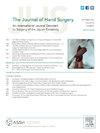Pain Interference Prior to and 1 Year After Surgery for Adult Traumatic Brachial Plexus Injury
IF 2.1
2区 医学
Q2 ORTHOPEDICS
引用次数: 0
Abstract
Purpose
Pain after brachial plexus injury (BPI) can be severely debilitating and is poorly understood. We hypothesized that pain interference (PI) (“the extent to which pain hinders engagement in life”) would be predicted by depression, anxiety, severity of pain symptoms, and poorer preoperative muscle function.
Methods
Among patients in a prospective multicenter BPI cohort study, 37 completed Patient-Reported Outcomes Measurement Information System (PROMIS) PI questionnaires before and 1 year after surgery. At both times, participants completed anxiety and depression questionnaires and BPI-specific measures of pain symptoms, physical limitations, and emotional recovery. Surgeon-graded muscle testing, injury severity, age at the time of injury, body mass index, and time from injury to surgery were included. We performed a bivariate analysis of predictors for preoperative and 1-year PROMIS PI followed by multivariable regression modeling using stepwise selection and Bayesian Information Criterion to select covariates.
Results
Before surgery, the mean PROMIS PI score was 60.8 ± 11.0, with moderate correlations between PROMIS PI and depression, as well as between PROMIS PI and functional limitations. At 1 year after surgery, the mean PROMIS PI score was 59.7 ± 9.5. There was no difference in preoperative and 1-year PROMIS PI. There were strong correlations between PROMIS PI and pain symptoms, functional limitations, and emotional aspects of recovery at the 1-year follow-up that remained significant in multivariable regression. There were no notable associations between muscle testing and PI.
Conclusions
Pain interference remained substantial and elevated in BPI patients 1 year after surgery. We noted strong associations between PI and pain symptoms, functional limitations, and emotional aspects of recovery. These findings demonstrate the persistence of pain as a feature throughout life after BPI and that its treatment should be considered a priority alongside efforts to improve extremity function.
Type of study/level of evidence
Prognosis IV.
成人外伤性臂丛神经损伤手术前后一年的疼痛干扰。
目的:臂丛神经损伤(BPI)后的疼痛会严重削弱患者的能力,但人们对其了解甚少。我们假设疼痛干扰(PI)("疼痛妨碍生活的程度")会受到抑郁、焦虑、疼痛症状严重程度以及术前肌肉功能较差的影响:在一项前瞻性多中心 BPI 队列研究中,37 名患者在术前和术后 1 年填写了患者报告结果测量信息系统(PROMIS)PI 问卷。在这两个时间段,参与者都填写了焦虑和抑郁问卷,以及针对疼痛症状、身体限制和情绪恢复的 BPI 特定测量。外科医生分级的肌肉测试、受伤严重程度、受伤时的年龄、体重指数和从受伤到手术的时间也包括在内。我们对术前和术后 1 年 PROMIS PI 的预测因素进行了双变量分析,然后使用逐步选择法和贝叶斯信息标准进行多变量回归建模,以选择协变量:手术前,PROMIS PI的平均得分为60.8 ± 11.0,PROMIS PI与抑郁之间以及PROMIS PI与功能限制之间存在中度相关性。术后一年,PROMIS PI 的平均得分为 59.7 ± 9.5。术前和术后1年的PROMIS PI没有差异。PROMIS PI与疼痛症状、功能限制以及术后1年的情绪恢复之间有很强的相关性,并且在多变量回归中仍然显著。肌肉测试与PI之间没有明显的关联:结论:手术 1 年后,BPI 患者的疼痛干扰仍然很严重,且呈上升趋势。我们注意到 PI 与疼痛症状、功能限制和康复情绪之间存在密切联系。这些研究结果表明,疼痛是 BPI 术后终生存在的一个特征,因此在努力改善肢体功能的同时,也应优先考虑治疗疼痛:预后 IV。
本文章由计算机程序翻译,如有差异,请以英文原文为准。
求助全文
约1分钟内获得全文
求助全文
来源期刊
CiteScore
3.20
自引率
10.50%
发文量
402
审稿时长
12 weeks
期刊介绍:
The Journal of Hand Surgery publishes original, peer-reviewed articles related to the pathophysiology, diagnosis, and treatment of diseases and conditions of the upper extremity; these include both clinical and basic science studies, along with case reports. Special features include Review Articles (including Current Concepts and The Hand Surgery Landscape), Reviews of Books and Media, and Letters to the Editor.

 求助内容:
求助内容: 应助结果提醒方式:
应助结果提醒方式:


